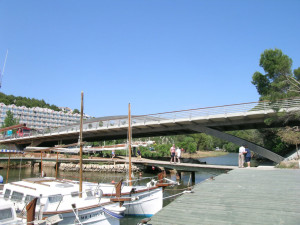
Vehicular and rail bridges
Structural engineering firms have also been using welded stainless steel plate fabrications in vehicular and railroad bridges as primary structural components. The first was Pedelta’s Cala Galdana Bridge in Menorca, Spain (right), which used duplex 2205 stainless steel structural components. The 2005 project replaced a mild steel-reinforced concrete bridge, which had severely deteriorated in the marine atmosphere.
The first stainless railway bridge was the Añorga Bridge in San Sebastian, Spain, which used a UNS 32101 truss structure and replaces a carbon steel structure that had required intensive maintenance over its lifespan. Other vehicular bridges that have used large stainless steel structural components include Arup’s 2009 Stonecutter’s Bridge in Hong Kong, which used 2205 plate on the exterior of the bridge pylons.
Many of these bridges were designed using EuroCode 3, which is overly conservative based on recent research. Design firm Ove Arup & Partners conducted a study for Outokumpu—“Outokumpu Stainless Steel Composite Bridge Study: Life Cycle Cost for Maintenance Study” (2012) and “Outokumpu Stainless Steel Composite Bridge Study: Study Report” (2011)—comparing 355 N/mm2 (51 ksi) minimum yield carbon and weathering steel with various stainless steels. The comparison used a two-span 28-m (92-ft) long bridge carrying a two-lane highway. EuroCode 3 was used for the initial analysis; then, an optimized design was developed using research incorporated into American Institute of Steel Construction (AISC) Steel Design Guide 27, Structural Stainless Steel.
The Arup study found duplexes to be the most cost-effective stainless steel alloy family for bridge design. (UNS S32101 and S32205 were included in the study.) With design optimization using stainless steel, 12 percent less tonnage was required then carbon or weathering steel. The initial cost of the lean duplex bridge was only 7.4 percent greater than that of the carbon steel bridge and five percent more than weathering steel.
A full lifecycle cost analysis was done based on 60 years of service. The model assumed maintenance repainting of the carbon steel every 10 years without removal of previous paint layers. Several scenarios were considered and a 30 to 40 percent cost savings could be achieved over 60 years by using duplex stainless steel.
 Catherine Houska, CSI, is a senior development manager at TMR Consulting. She is a metallurgical engineering consultant specializing in architectural metal specification, restoration, and failure analysis. Houska was a member of the steering committee for American Institute of Steel Construction (AISC) Steel Design Guide 27, Structural Stainless Steel, and has authored more than 160 publications, including several features for The Construction Specifier. She can be reached via e-mail at chouska@tmr-inc.com.
Catherine Houska, CSI, is a senior development manager at TMR Consulting. She is a metallurgical engineering consultant specializing in architectural metal specification, restoration, and failure analysis. Houska was a member of the steering committee for American Institute of Steel Construction (AISC) Steel Design Guide 27, Structural Stainless Steel, and has authored more than 160 publications, including several features for The Construction Specifier. She can be reached via e-mail at chouska@tmr-inc.com.





Thanks for sharing these examples of stainless steel duplex bridges! I had no idea that steel was becoming the main material used in bridges like this. However, you can’t make a dramatic design like the Celtic Gateway unless you are using really strong materials– I can’t imagine you couldn’t build that same structure with wood!
Construction Specifications Institute – CSI Salt Lake …